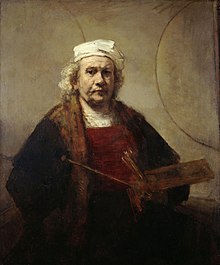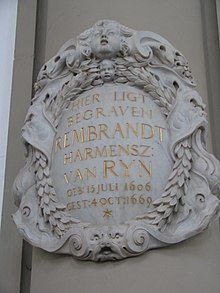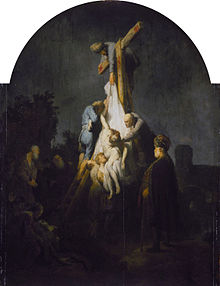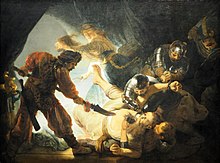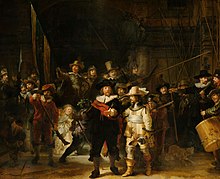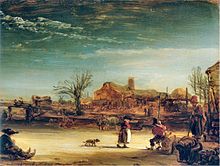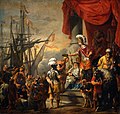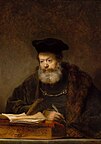Rembrandt van Rijn
Rembrandt Harmenszoon van Rijn (* July 15, 1606 in Leiden ; † October 4, 1669 in Amsterdam ), known by his first name Rembrandt , is one of the most important and well-known Dutch baroque artists . His work fell into the era of the Golden Age , when the Netherlands experienced a political, economic and artistic heyday. Rembrandt studied with Pieter Lastman, opened his first studio in Leiden in 1625 and soon attracted attention. In 1631 he moved to Amsterdam, where he became a celebrated artist. Nevertheless, at times he suffered from serious financial problems, went into 1656 bankruptcy and died in poverty.
Rembrandt worked as a painter , etcher and draftsman , ran a workshop and trained artists. His oeuvre includes, among other things, portraits , landscapes as well as biblical and mythological subjects. His best-known works include The Blinding Simsons , The Night Watch , The Anatomy of Dr. Tulp and the Hundertguldenblatt . In his historical depictions, Rembrandt took up numerous motifs that had not previously been artistically processed, or he was looking for new ways of depicting traditional motifs. Many of these works are characterized by strong light-dark contrasts, which is why he is considered a master of Chiaroscuro .
Rembrandt was already received during his lifetime through re-engravings and copies of his pictures. After his death, his coloristic style of painting was rated negatively in the art criticism and art literature of classicism , while his works enjoyed great popularity with collectors and achieved high prices. In the 18th century, Rembrandt found successors among German and English artists. During this time his life was mystified and embellished with legends. It was not until the middle of the 19th century that his real biography was extracted from this Rembrandt picture through source research. The Rembrandt Research Project has been researching Rembrandt's works since the 1970s . It examined these for their authenticity, so that the number of pictures that Rembrandt himself can be shown to have painted has reduced from what was supposedly more than 700 to around 350.
Life
childhood and education

Rembrandt was born on July 15, 1606 in Leiden, the eighth of nine children. The parents were the miller Harmen Gerritszoon van Rijn and his wife Neeltgen Willemsdaughter van Zuytbrouck, a baker's daughter . Like many other children in the city, Rembrandt attended elementary school between 1612 and 1616 and then, from 1616 to 1620, the strictly Calvinist Latin school . There he was taught Biblical history and the classics. Rembrandt also received rhetoric lessons, which may have influenced his painting. After eight years of school he enrolled in the philosophy faculty of the University of Leiden .
He broke off this course after a short time to begin training as a painter. From 1620 to 1624 he was a student of Jacob Isaacsz van Swanenburgh . The teacher, trained in Italy , specialized in architectural painting and the scenic depiction of hell and taught his students the basics of painting. The design of the fire in the portraits of Hell may have sparked Rembrandt's interest in the representation of light. He then completed a six-month apprenticeship with the history painter Pieter Lastman in Amsterdam in 1624 , which influenced him more than his previous training. Lastman introduced him to history painting, which held the highest position in the hierarchy of painting genres that was valid at the time. Training with two masters was not unusual at the time.
Beginning of working life
In 1625 Rembrandt returned to Leiden. There he founded his own workshop with his friend Jan Lievens . He devoted himself primarily to history painting based on the model of his teacher Lastman and physiognomic studies. Three years later he made an etching for the first time and began taking in students. In the same year the secretary of the governor Friedrich Heinrich , Constantijn Huygens , who visited Leiden in November 1628, showed an interest in Rembrandt's art. As a result, he supported the artist and gave him orders. Rembrandt was able to sell two paintings to the English crown in 1629 and 1630. The resurrection of Lazarus and Judas brings back the thirty pieces of silver were copied several times by other artists. Rembrandt's father died on April 27, 1630.
After his first successes and attracted by the increasing importance of the Dutch capital, Rembrandt gave up the Leiden studio that he ran with Lievens in 1631 and moved to Amsterdam . There he bought himself from the art dealer Hendrick van Uylenburgh , who owned a large workshop in which copies were made and restorations were carried out. After a short time Rembrandt received portraits from wealthy merchants. In the following year, governor Friedrich Heinrich bought some paintings by Rembrandt through the mediation of Constantijn Huygens and commissioned a cycle of passion . Also in 1632 Rembrandt received the commission for the picture The Anatomy of Dr. Tulp , which he completed in the same year. A total of 30 paintings were created this year. Rembrandt probably worked as a workshop manager for Uylenburgh, because before he was accepted into the Amsterdam Guild and the associated independence, he first had to have worked for another master craftsman or in a workshop.
Self-employment and marriage
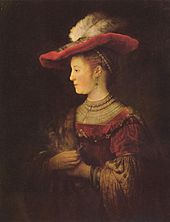
by Rembrandt van Rijn, oil on wood, Gemäldegalerie Alte Meister, Kassel
On July 2, 1634, Rembrandt married Saskia van Uylenburgh , the niece of his art dealer and daughter of a wealthy patrician . In the same year he joined the Guild of Luke . This enabled him to train apprentices and students as an independent master. In 1635 he worked, among other things, on the pictures The Sacrifice of Isaac and Samson threatens his father-in-law . Rembrandt's first son, baptized Rombertus (different spelling Rombartus) on December 15, 1635, died after a few months. In 1636 the couple, who until then had still lived with the art dealer Uylenburgh, moved to the Nieuwe Doelenstraat . In addition to his artistic activity, Rembrandt traded works of art there and built up a collection of historical and scientific objects, plants and animals as well as exotic objects (objects from distant countries such as India). In 1638, Rembrandt sued his wife's relatives in a libelous lawsuit for accusing them of wasting money. The relatives of Saskia justified this accusation with the fact that their inheritance of around 40,000 guilders had almost been used up. Also in that year his first daughter named Cornelia was born, who died a short time later.
On January 5, 1639, Rembrandt bought a new house in the Breestraat , which is now the Museum Het Rembrandthuis . To do this, he took out a loan that he wanted to pay off in five to six years. The last painting of the Passion Cycle was completed in 1639. The year 1640 was marked by two strokes of fate for Rembrandt: His second daughter, who was baptized Cornelia on July 29, died shortly afterwards. Rembrandt's mother also died a month later.
Artistically, a turning point took place when he began to devote himself to landscape painting and the etching of landscapes. His second son Titus was baptized on September 22, 1641. The following year Rembrandt completed The Night Watch . His wife Saskia died on June 14, 1642. This event marked a deep turning point in Rembrandt's life. While the years before were characterized by high productivity, his artistic activity now slackened significantly. He created only a few paintings and etchings , such as the Hundertguldenblatt , which is one of his most famous works . He also identified himself strongly with his father role and took special care of his son Titus. Rembrandt also took up his family situation in works of art, such as the drawing showing a man feeding a child. So that she would relieve him of the household chores, he brought Geertje Dircx to him, who developed a particularly close relationship with Titus. She considered him the main heir in her will when she became seriously ill in 1648. In 1649 Rembrandt hired the much younger Hendrickje Stoffels .
Financial problems and last years of life
After Hendrickje became Rembrandt's new partner, there was a dispute with Geertje Dircx. In 1649 she sued him in court for alimony and obtained that Rembrandt was sentenced to a higher payment. When, contrary to what had been agreed in court, she pledged further jewelry the following year that she had received from Rembrandt, he and her brother collected incriminating statements against her and ensured that she would spend five years in a reformatory (the Spinhuis in Gouda ) had to.
In 1652 Rembrandt received the commission from the Sicilian patron Antonio Ruffo to paint the picture of Aristotle with the bust of Homer . Despite the good order book, the proceeds from the sale of etchings and the fees from his teaching activities, he was unable to pay off his debts and had to continue to borrow money. In 1654 Hendrickje Stoffels was summoned to the Amsterdam Church Council, which reprimanded her for indecent coexistence with Rembrandt. She gave birth to Rembrandt's third daughter, also named Cornelia and baptized on October 30, 1654.
Rembrandt signed his house to his son Titus on May 17, 1656, before he was declared bankrupt shortly afterwards. In the two years that followed, the house and its collection were auctioned off. The debt could not be fully paid with the proceeds. Rembrandt then moved to Rozengracht , where mainly socially disadvantaged groups lived. There he led a secluded life among Mennonite and Jewish friends. The guardianship of Titus was taken over by Louys Crayers (1623–1688), who won the inheritance for Titus from the bankruptcy estate in a long process. In 1660, Titus and Hendrickje Stoffels employed Rembrandt in their art shop. This enabled him to maintain business contacts, continue to take assignments and teach students. Ruffo acquired the picture Alexander the Great in 1661 and ordered a painting to show Homer . Hendrickje Stoffels died in 1663.
In 1665 Titus came of age and received his inheritance. At the same time Rembrandt was working on the painting The Jew's Bride . His son, who had married Magdalena van Loo six months earlier, died three years later and was buried on September 7, 1668. After this event, Rembrandt moved in with his daughter-in-law. This gave birth to his grandson, whose godfather he became on March 22, 1669. Rembrandt died on October 4th of the same year. The picture of Simeon in the temple was left unfinished. Rembrandt was buried in the Westerkerk on October 8th .
Works
Were attributed to Rembrandt in the 1920s or in part more than 700 paintings, the experts will now believe that his body of work about 350 paintings , 300 etchings and 1,000 drawings included.
The main subjects of his paintings and etchings are histories and portraits, including self-portraits. Many of the history paintings and etchings show artistically processed biblical scenes and myths here for the first time or implement a traditional theme in a significantly different way than was done in models. In addition, Rembrandt was a successful portrait painter who succeeded in credibly involving the portrayed in actions. The self-portraits bear witness to his self-view and convey his examination of his own aging. The etchings in particular show him with different facial expressions and gestures and thus also served for study purposes. Rembrandt painted and etched only a few landscapes and genre scenes . With the picture Dead Peacocks , only one still life is known. Rembrandt made many of the drawings for his students only for study purposes. In some he also recorded small incidents from his private life and other impressions.
Rembrandt provided his first pictures with the monogram RH , later with RHL , where the L stands for the city of Leiden . At the age of 26 he began to sign his works with Rembrant . From the beginning of 1633 he signed with Rembrandt , the spelling of his name that is widespread today.
painting
History painting
Many of Rembrandt's paintings can be assigned to the genre of history painting . They show scenes from the Old and New Testament , myths or portraits of historical personalities. In doing so, Rembrandt developed a particularly condensed representation of the plot, so that narrative contexts that extend beyond this are expressed in the depiction of a certain moment. The focus on history was also a result of his training with the famous history painter Pieter Lastman , on whose themes and compositions Rembrandt initially orientated himself. An example of this is the painting Stoning of Saint Stephen from 1625, which is one of the earliest works by Rembrandt. For a long time it was considered a painting by Lastman, whose work it is stylistically very similar. Rembrandt used the composition of a lost Lastman painting with the same theme, but already made use of his typical use of light and shadow. The Pharisees and elders in the background are brightly lit as the driving forces behind the execution, while the executing persons in the foreground are shaded. He should use this remedy over and over again to emphasize people and actions.
Between 1632 and 1646 Rembrandt produced a cycle of seven paintings from the childhood story of Jesus and the Passion . The order was placed by the governor Friedrich Heinrich on the mediation of Constantijn Huygens and originally comprised the five images Descent from the Cross , Erecting the Cross , Ascension , Entombment and Resurrection , which is why the name has become established in specialist literature as the Passion Cycle. Rembrandt painted the two paintings Adoration of the Shepherds and Circumcision in the Temple , which is only known today through a copy, as a supplement to this cycle. Rembrandt delivered the pictures at long intervals and sometimes with a delay, which is why he tried to “bribe” Huygens with other pictures and in this context made The Blinding Simsons . The time frame of the work also caused differences in the dimensions of the pictures, the colors, the size of the figures and the painting style as a whole, so that the series of pictures is not a homogeneous work. When painting the Descent from the Cross , Rembrandt examined a composition by Peter Paul Rubens that he knew from an engraving. Rubens had depicted the body of Christ parallel to one another and arranged all helpers around it. Rembrandt changed this structure fundamentally. The cross is placed at an angle and the people are divided into groups who either mourn Jesus or help him remove him from the cross. To the right of the corpse Rembrandt depicted Nicodemus , as was customary in comparable history paintings, to the left of him he showed Mary , who is supported by two women. Their presence does not go back to the Bible, but takes up a legend that arose in the Middle Ages. Rembrandt placed the emphasis on the suffering of the crucified Christ in the depiction. The bloody traces of the crowning of thorns, the nailing and the wound on the side can still be seen on the bars of the cross. The contrast between light and dark emphasizes the cross and the corpse as well as the hands and faces of the mourners.
The 205 centimeter high and 272 centimeter wide painting The Blinding Simsons is one of Rembrandt's most important paintings. It shows an episode from the story of the judge Simson , which Rembrandt treated in several pictures. Samson was a Nazarite , which gave him special strength when he adhered to three conditions, such as the prohibition on cutting his beard and hair. The scene depicted here follows on from the cutting of the hair by Delilah , who betrayed him to the Philistines . This aspect of the plot is also taken up in this painting, as Delilah is depicted in the background fleeing with a mop of hair and scissors in hand. Rembrandt also portrayed various aspects of the plot with the other people. For example, after his hair had been cut off, Samson had to be wrestled to the ground and tied up before his eyes were gouged out. Rembrandt conveyed this through the fighters, one of whom enters the scene fearfully, another holds Samson on the ground, one ties him and one pokes out his eyes. The immediate action of the painting is the climax of the story, the blinding with the penetrating knife, whereby the blood splatters. The viewer can, however, reconstruct the entire plot through the image.
In addition to striving to convey as much action as possible in his pictures, even beyond the depicted moment, and to depict the action at its peak, such as Samson's dazzling , Rembrandt also included external influences from his immediate surroundings in his histories. This becomes particularly clear in the example of the representation of Jews. For a long time, Rembrandt used physical characteristics assigned to Jews only in depictions in negative contexts, such as with the high priests , and he reinforced these traditionally depicted facial features. After moving due to bankruptcy, he studied directly on Jewish models for the first time. One of these studies is the painting A Christ after Life , in which he painted the Son of God, whose appearance was otherwise similar to that of Dutch models, with Jewish facial features.
In 1653 Rembrandt painted the historical half-length Aristotle on behalf of the Sicilian aristocrat Ruffo , a picture that is one of Rembrandt's important late works. Two more pictures followed later, on Ruffo's order, showing Alexander the Great and Homer . Ruffo was very satisfied with the portrait of Aristotle and mentioned it with praise in a letter to the painter Giovanni Francesco Barbieri , who was supposed to make a counterpart , because Rembrandt only delivered the two other pictures ordered after a long delay at the beginning of the 1660s. The portrait of Alexander the Great was also well received by Ruffo, but after a while he noticed that the canvas had been enlarged on three sides and then complained. Ruffo felt the Homer was incomplete, which is why he sent it back and asked Rembrandt to rework it. Rembrandt seems to have chosen the subjects of the pictures himself, since he already laid out the following two in the Aristotle portrait. The philosopher is depicted in a moment of reflection. He has placed his right hand on a bust depicting Homer. With his left hand he touches a golden honor chain with a portrait of Alexander the great at waist height. This also expresses Rembrandt's knowledge of the historical context. Aristotle was a connoisseur of Homer's works and passed them on to his pupil Alexander the Great.
Portraits and group portraits
After moving to Amsterdam, Rembrandt began to paint more portraits while working in Uylenburgh's studio, and with them quickly conquered the market for this genre. The success was based on experiences from history painting, with which Rembrandt surpassed the established portrait painters. He involved the portrayed in small acts, such as the handing over of a letter by the woman to her husband in a double portrait, which gives the pictures liveliness. Rembrandt also succeeded in reproducing human skin in a particularly realistic way. Compared to other portrait painters, Rembrandt took more liberties, so that his pictures show less similarities in physical characteristics compared to other portraits of the same person. The two-line “This is Rembrandt's hand, and de Gheyn's face. Amazement. Reader, that is de Gheyn and it is not. ” By the poet Constantijn Huygens on the portrait of his friend Jakob de Gheyn the Younger is viewed as a criticism of the portrayal of de Gheyn by Rembrandt or as a reflection that a portrait is not the portrayed person himself, but only an image of him is interpreted.
The first group portrait painted by Rembrandt, which marked his breakthrough as a portrait painter, is the 169.5 centimeter high and 216.5 centimeter wide painting The Anatomy of Dr. Tulp , which was created in 1632 shortly after moving to Amsterdam on behalf of the prelector of the surgeons ' guild , Nicolaes Tulp . It shows a public anatomy lecture that was commonplace and popular at the time. Rembrandt did not depict the people portrayed in a row, as was the tradition, but depicted them gathered around the corpse. The tendon on the left forearm is exposed and the surgeon lifts it with the pliers while he is giving his lecture. With the exception of Tulps, who is sitting on an armchair, all figures that can be identified as members of the guild stand and are shown in poses that are typical for following a lecture. Rembrandt shows the concentrated gaze on the speaker as well as an examining one in the textbook in the lower right corner of the picture or the expert sampling of the preparation. Thus all figures are united in a common event. The individual facial features are more clearly worked out than the situation requires, which seems like an exaggerated pose to today's observer. Over time, however, Rembrandt abandoned this exaggeration.
An example of the individual portraits created at the beginning of the Amsterdam period is the 130 centimeter high and 103 centimeter wide portrait of the preacher Johannes Uytenbogaert , which was painted by Rembrandt in 1633 on behalf of the Remonstrant congregation. It shows the pastor Johannes Uytenbogaert , who had returned to the Netherlands for a short time from his exile. He noted in his diary for April 13, 1633 that he was a model for Rembrandt all day. Parts of the picture, such as the hands, did not come from Rembrandt himself, but were painted by a studio employee. This practice appeared in some of Rembrandt's portraits, as it was not uncommon for different painters to work on one picture in portrait workshops.

One of Rembrandt's most famous paintings is the group portrait The Night Watch , painted in 1642. The 363 centimeters high and 437 centimeters wide image was from the Guild of riflemen commissioned, which moved into a new clubhouse and jewelry of the banquet hall ordered several group portraits. Rembrandt fulfilled this mandate as he did with the anatomy of Dr. Tulp by tying the portrayed into a plot. The captain Frans Banning Cocq gives the marching orders to Lieutenant Willem van Ruytenburgh, who now passes them on. The captain and lieutenant stand in the center of the foreground as the starting point for the plot. Individual members of the company have noticed the order and are preparing to march. The activity of the guild is symbolized by three shooters who show different phases of the shot. In the left foreground someone is stuffing the rifle, behind the lieutenant the muzzle flash of a firing rifleman can be seen and to the right of the lieutenant an old man is blowing spent powder from the ignition pan. In the left half of the picture Rembrandt depicted two little girls who appear as sutlers and of whom only the one in front can be recognized as an allegory . She wears a chicken on her belt, the claw of which was the symbol of the gunmen's guild, the guild's drinking horn and a pie . The picture points to the celebration of the guild community with a meal together. Rembrandt's hint of other figures in the background gives the impression that the whole company is present, which not only included shooters, but also spear-bearers and lance-bearers. The painting shows a normal deployment of the guild, which is why titles such as Captain Frans Banningh Cocq gives his lieutenant the order for the civil company to be deployed were widespread for a long time . It was only when the layers of varnish had darkened and the picture therefore appeared like a nocturnal scene that the title The Night Watch became established towards the end of the 18th century . Various rumors and anecdotes surround the picture, such as that the portrayed are members of a theater group or that Rembrandt's reputation as a portrait painter has deteriorated due to the unusual composition of the picture. These speculations are rejected by research.
The 99.5 centimeter high and 83 centimeter wide portrait of a lady with an ostrich feather is an example of Rembrandt's portraits of women and his portraits in the last decade of his life. From the beginning of the 1660s, Rembrandt experienced an increase in the number of these commissions after a long period with a few portrait commissions. These works are all characterized by a strong chiaroscuro and a calm demeanor on the part of the sitters. The portrait of the unknown woman holding a peacock feather is shaped by two light triangles. The upper one includes the head and shoulders, the lower one the forearms, hands and the feather. Both are separated by a black area of clothing. This stands out only slightly from the background, which is also dark.
Self-portraits
Throughout his life, Rembrandt made portraits that show him with different gestures and different facial expressions as well as in different roles. He represented himself "almost fifty times in color, twenty times in etchings and about ten times in drawings".
Rembrandt studied himself primarily at the beginning of his career, when he made etchings that depict him in various emotional states with the associated postures and body language. In his later work, instead, he increasingly made portraits that had his age as a theme or in which he assumed historical roles.
The 102 centimeter high and 80 centimeter wide self-portrait from 1640 shows Rembrandt against a light, neutral background, so that the figure is particularly emphasized. He wears clothes made of silk and brocade . The coat is trimmed with a fur collar . A heavy and precious stole lies over the arm resting on a barrier . Rembrandt wears a beret as headgear . The face is painted in half profile with a melancholy expression. The gaze is directed towards the viewer of the picture. The signature Rembrandt f. 1640 is visible in the lower right corner of the picture on the barrier . With the perfect painting style and the portrayal of the person portrayed, this picture resembles works by Raphael or Titian .
Rembrandt's aging can be traced in his portraits. The pictures show him with thinning hair and growing wrinkles. However, he not only portrayed himself, but also partly placed himself in a larger narrative context by taking on historical roles. An example of this is the self-portrait as the Apostle Paul from 1661. It shows Rembrandt in dark clothes against a predominantly dark background. Only the upper left corner of the picture, where the signature is attached, is lighter. The white turban he wears as a headgear is the lightest section of the picture. Rembrandt holds a copy of the Old Testament in his hand ; the letters shown are based on the Hebrew script . The sword as a typical attribute of the apostle Paul of Tarsus , who was executed with one of these, is only indicated by its pommel. Another painting from this creative phase is the self-portrait as Zeuxis around 1663/64, which for a long time was considered a representation of Democritus . In ancient times, Democritus was considered the laughing philosopher , due to his doctrine of goodwill as the highest good. The interpretation as Democritus was also linked to the interpretation that Rembrandt viewed his aging positively. According to the current state of research, however, this picture shows Zeuxis of Herakleia , who died of a laughing fit while painting a portrait of an ugly woman. The picture could thus also symbolize Rembrandt's knowledge of his own arrogance and mortality. However, this interpretation is not considered certain either. It is alleged that X-ray examinations found that Rembrandt only smiled and did not laugh in an earlier version of the picture.
Landscapes
Rembrandt's insolvency inventory list from 1656 lists twelve landscape paintings by his hand, eight of which have survived according to current knowledge. In addition, 32 etchings and numerous drawings depicting landscapes are ascribed to him. During Rembrandt's lifetime, landscape paintings were classified under portrait and history painting in the traditional hierarchy of genres and were accordingly cheaper. Rembrandt himself will have seen himself as a history painter. He drew landscapes while hiking in the vicinity of Amsterdam rather for his personal enjoyment. This explains why he created only a few landscape paintings that also differ significantly from those of his contemporaries.
In the period between 1636 and 1655 Rembrandt painted some landscape paintings , which does not necessarily mean that these pictures do not contain figures. The majority of them show fantasy landscapes, only a minority were painted realistically by Rembrandt. In contrast to his drawings and etchings, which mostly show wide, open and realistic landscapes, the paintings appear mostly motionless and cramped. In contrast to the histories and portraits, Rembrandt's landscape paintings differed greatly from the traditional paintings of this genre. They had a limited influence on subsequent artists in England around the year 1800. While many Italian artists and artists emulating the Italians chose landscapes from Roman or Greek antiquity , Rembrandt often painted those that can be more closely assigned to the Israeli region . Like the painters of idealized landscapes, Rembrandt did not depict reality in his paintings. He went even further, however, by also dispensing with the basis of studying nature for painting the picture.
An example of the fantastic landscapes is the painting Landscape with Buildings , which Rembrandt created between 1642 and 1646. It is the most classical landscape composition among his works and is probably based on the landscape with the Flight into Egypt by Annibale Carracci from 1604 , a painting that Rembrandt should have known as a copy. In both pictures a group of buildings dominates the horizon. Some of them are illuminated by the sun, the other is in the shade. The buildings are integrated into the landscape in terms of color and composition in such a way that they appear to naturally belong to it. In the foreground you can see a river with a bridge over it. It is possible that Rembrandt did not complete the painting and therefore no figures are integrated into the picture.
One of the realistic landscapes is the 17 × 23 centimeter winter landscape from 1646. The small format and the execution suggest that it is based on a drawing. The representation of the weather and the clouds is based on reality. The foreground of the picture is relatively empty. In his left corner there is a man, in his right half there are three other figures. In terms of execution, this landscape is not as representative and magnificent as many other winter landscapes that were created in the Netherlands in the 17th century.
drawings

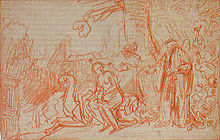
Of the numerous drawings that Rembrandt made in the course of his life, around 1,000 have survived. He sold only a few of these drawings, most of them for study purposes. These were sketches, preliminary drawings, traces of drawings and mementos that were available to his students in the workshop, sorted by topic. Some drawings show that Rembrandt was more concerned with certain problems. In the second half of the 1630s, for example, he devoted himself to symmetry and asymmetry in Leonardo da Vinci's work The Last Supper . This was known to Rembrandt through an engraving and prompted him to study the structure of this picture in various drawings. Rembrandt transferred the knowledge he gained in this way to the painting Samson at the wedding table, giving up the riddle that is based on the Lord's Supper in the composition.
Over time, Rembrandt repeatedly dealt with the representation of certain topics, such as the story of Susanna in the bath . An example of the implementation of this biblical story is the drawing Susanna in the bath made with red chalk , which was made around 1637. In terms of composition, it is based on a history painting by Pieter Lastman , with whom Rembrandt had studied. According to the biblical story, Susanna is harassed by two old judges and given the choice of either doing their thing or being slandered. Rembrandt took over the large layout of the picture, the grouping of the figures and essential pictorial elements from Lastman in his chalk drawing. The main difference to the original lies in the further development of the scene, with Rembrandt emphasizing the dialogue character. He uses the body language of the two old people to convey Susanna's alternatives: the one on the left points to the lock as a threat of defamation and accusation, the one on the right lures Susanna with his finger. Susanna gives the latter a dismissive look, which shows her rejection of the suggestion.
More recent Rembrandt research no longer sees a large part of the drawings in his late work primarily as the originally assumed "preliminary drawing character" - they are now regarded as autonomous works of art. One of Rembrandt's favorite techniques was the bourdon tube pen , often washed in brown ink.
Etchings


Rembrandt created around 300 etchings, 80 of which copper plates have survived. Their dissemination via reproductions contributed to the artist's fame throughout Europe during his lifetime. Rembrandt's early etchings show clear style differences to his contemporaries and suggest that he approached this art genre as an autodidact . Rembrandt's technique was freer than that of other artists, who approached copperplate engraving with regular lines and hatching so that his etchings appear more vivid. With the play of light and dark and the perspective created by different hatching, he gave them a painterly character.
The Landscape with the Three Trees from 1643 is one of Rembrandt's first realistic depictions of landscapes, after he created heroic landscapes with obelisks , waterfalls and castles in his earlier paintings . Now he concentrated on the vastness of the landscape and the representation of the clouds. The etching The landscape with the three trees shows the flat landscape typical of the Netherlands after a thunderstorm.
The 38.5 centimeter wide and 45 centimeter high etching The Three Crosses from 1653 shows an interpretation of the Calvary scene , a traditional subject of pictures that Rembrandt approached from a new point of view. He focused on the reactions of those present to Jesus' death and the subsequent earthquake and the three crosses. Rays of light break out of the sky, emphasizing the sacred character of the etching in their geometric structure. They illuminate Jesus and the good thief , while the second robber remains in the dark. Rembrandt presented the effect on the people present in different ways. For example, the captain fell on his knees, while on the left edge of the picture in the foreground an overwhelmed man is being led away. The design of this man was borrowed by Rembrandt from an engraving by Lucas van Leyden , which shows the shock of Paul after his conversion. Furthermore, women have fallen to the ground and most of the characters depicted show feelings of despair, fear and pain in some way. In it, Rembrandt mainly received depictions from the Renaissance and antiquity .
collection
Rembrandt probably began building up his extensive collection of various objects and works of art in Leiden. From 1628 onwards, precisely reproduced exotic and ethnological objects can be found in the works of Rembrandt, which suggest that the collection was also used for study purposes and included studio props. But it could also have been a supply of valuable objects that were intended for sale, since Rembrandt was also an art dealer . With the encyclopedic claim of the collection, Rembrandt might also want to distinguish himself in the higher circles of society.
The collection was divided into two areas, on the one hand in the naturalia such as hard corals and shells , on the other hand in the artificialia , which included objects such as coins , weapons , musical instruments and plaster casts of busts of Greek philosophers and Roman emperors. Rembrandt divided the collection of works of art into paintings, paper art, copperplate engravings and woodcuts . It included, among other things, paintings by masters who had a strong influence on him, such as Pieter Lastman and his circle, Hercules Seghers and artists who were friends or who were stylistically related, such as Jan Lievens . Rembrandt also owned works by Palma Vecchio , Lucas van Leyden , Raffael and Peter Paul Rubens . The copper engravings came from, for example, Hans Holbein the Younger and Martin Schongauer . An entire album was filled with engravings and woodcuts by Lucas Cranach the Elder . Furthermore, were Titian , Mantegna , Michelangelo , Annibale and Agostino Carracci represented in the collection.
As a result of his bankruptcy, Rembrandt also had to part with his collection. Based on the inventories drawn up before the auction, the extent of the collection and the works and objects contained therein are still known today. A short time later, when he had moved into a small apartment, he acquired a new collection. This suggests that collecting was some kind of obsession for Rembrandt . The Museum Het Rembrandthuis in Amsterdam is presenting a reconstruction of the collection from around 1650. It was based on the inventories, which also spatially assigned the exhibits.
Significance and aftermath
Workshop and student
Between 1628 and 1663 Rembrandt trained students in his workshop. In Leiden, his studio was in his parents' house, so there was no separation between home and work. His first pupil there in February 1628 was Gerard Dou , who would later become famous with his genre paintings and portraits. Isaac Jouderville followed in November of the same year . In Amsterdam, Rembrandt first worked in the workshop of the art dealer Hendrick van Uylenburgh until he joined the Guild of St. Luke in 1634 and was thus given the right to run his own workshop and take on students. In his house he set up his studio on the first floor and the workshop in which his students worked on the second floor, under the roof. For the students, small work rooms were separated by movable partitions. They had access to drawings, engravings and paintings by their master, which they copied or reproduced in free variations. Rembrandt sold this work, which supplemented the 100 guilders that the parents had paid for one year. The tuition fee was very high considering that Rembrandt offered the students neither housing nor food. After completing their apprenticeship, some students remained as assistants in Rembrandt's workshop.
- Example works by Rembrandt students
Aeneas on the Lazio coast , 1661–1663, Gerard Dou , Rijksmuseum in Amsterdam
View of Delft , 1652, Carel Fabritius , National Gallery , London
Self-portrait as Zeuxis , 1685, Arent de Gelder , Städel in Frankfurt am Main
Christ before Pilate , Nicolaes Maes , Szépművészeti Múzeum in Budapest
The exact number of students is not known. Rembrandt's early biographers have handed down the names of around 20 of them. The records of Rembrandt's pupils in the guilds of Leiden and Amsterdam were lost. Today their number is estimated at around 50. From the German artist Joachim von Sandrart , who lived in Amsterdam from 1637 to 1645, it was said that “countless” young men studied and worked with Rembrandt. This statement suggests a higher number of students. The students included Carel Fabritius , Ferdinand Bol , Willem Drost , Gerbrand van den Eeckhout , Govert Flinck , Arent de Gelder , Samuel van Hoogstraten , Nicolaes Maes , Jürgen Ovens , Lambert Doomer and Franz Wulfhagen .
Respect and awareness
Rembrandt achieved national fame and fame very early on. The English traveler Peter Mundy , who was in the Netherlands in 1640, noted in his diary that “there were numerous outstanding artists in this country, some still exist, for example Rembrandt”. A year later, the early Rembrandt biographer and city historian of Leiden Jan Janszoon Orlers wrote about Rembrandt “that he has become one of the most renowned painters of our century”. The English crown acquired two of his pictures as early as 1629 and 1630, and knowledge of his works spread through large parts of Europe through engravings. Rembrandt sold three pictures to the Sicilian Antonio Ruffo , who put them on a list of the hundred most beautiful paintings in his collection.
After Rembrandt's death, the view of his work was divided. The classical conception of art dominated between 1750 and 1850 in Italy, France, the Netherlands and England and stood in contrast to colorism , to which artists such as Caravaggio and Rembrandt can be assigned. In the Teutsche Akademie , published in 1675, the German painter Joachim von Sandrart accused Rembrandt of "failing to observe the rules of art - anatomy, proportion, perspective, the norms of antiquity and the art of drawing by Raphael - and of having fought the sensible training in the academies" Sandrart also rated Rembrandt as uneducated and criticized his art collection, which he had previously praised in his biography, so that the public now considered it worthless. In 1681 Anries Pels published the didactic poem Gebruik en Misbruik des Toneels (Use and abuse of the theater) , in which he also went into painting and referred to Rembrandt as "the first (most famous) heretic in painting" because he had refused his "To subject famous brushes to the rules". The art writer Arnold Houbraken went even further in his work Groote Schouburgh from 1718 by inventing alleged quotations from Rembrandt and inaccurate biographical information, as well as spreading legends. By this point the facts about Rembrandt's life had largely been forgotten. Therefore, one inferred from his pictures that he had a low social status and a bad character. This was carried over to his artistic conception. In the approximately 20-page article, in which several authors besides Houbraken may have been involved, reference was made to many of the previous critics and reviews. The harsh criticism is countered by the fact that Rembrandt's works of art were popular with collectors. In Paris in the second half of the 17th and 18th centuries, when the artists active there created smooth ideal compositions, there was a large market for Dutch realists and, above all, Rembrandt. Due to the increased prices of his works, more and more forgeries came onto the art market. The existing interest prompted the French art dealer Gersaint to compile a first catalog of Rembrandt's etchings in 1751, which was tantamount to a pioneering work in art history.
Rembrandt's pictures were also well received in Germany and England and were acquired by both the bourgeoisie and the aristocracy. His works fetched such high prices in England that the British art dealer John Smith compiled the first catalog of the paintings in 1836. The pictures of Rembrandt, his students and successors, represented in collections all over Europe, inspired Rembrandt successors in the 18th century. In Germany, the painter Januarius Zick dealt with the costumes of the figures and the chiaroscuro painting in Rembrandt's paintings, in England Joshua Reynolds acquired paintings that Rembrandt had painted and oriented himself towards the coloring, in Italy Giovanni Battista Tiepolo dealt with compositions von Rembrandt's engravings, and the poets of Sturm und Drang , a movement in German literature from 1770 to around 1785, praised the folk and natural elements of Rembrandt's art.
After the erection of monuments to Albrecht Dürer in Germany and Peter Paul Rubens in Belgium, a Rembrandt monument was unveiled in Amsterdam in 1853. Even if this was mainly for patriotic motives, the result was a renewed interest among art historians in Rembrandt. For the first time, his life was thoroughly researched, with documents found in archives showing that previous publications contained a great deal of misinformation. In 1854 the first art- historical monograph on Rembrandt appeared, the author of which Eduard Kolloff knew many of his works from his own eyes . The basis of the actual Rembrandt research lies in these developments.
Important art historians such as Abraham Bredius and Wilhelm von Bode conducted research on Rembrandt and his environment. Jan Emmens corrected the image of Rembrandt as a breaker of the rules of art of his time, to which he was primarily made by the classical art literature, showed historical references and went into Rembrandt's studio work and his artistic models. Christian Tümpel dealt with misinterpreted and not yet interpreted historical representations of Rembrandt and the Rembrandt Research Project worked on clarifying the authorship of his paintings and that of those around him.
Rembrandt's success on the art market is unbroken. Works by him have achieved high auction results in recent years. On December 13, 2000, the portrait Elderly Lady with a Hood, painted in 1632 , was auctioned at Christie's in London (lot number 52) for 19,803,750 pounds, the equivalent of 28,675,830 dollars. The 1633 portrait A Gentleman in a Red Skirt from the collection of the Bellagio Gallery of Fine Art in Las Vegas was called up on January 26, 2001 at Christie's in New York (lot number: 81) and sold for $ 12,656,000 by the art dealer Noortmann acquired. On January 25, 2007, two pictures were offered at Sotheby’s in New York, of which the portrait A Woman with a Black Cap (Lot No .: 6) from 1632 for $ 9,000,000 and The Apostle James (Lot No .: 74) dating from 1661 were auctioned for $ 25,800,000. The portrait of A Man with Arms on His Hip (Lot No .: 12) from 1658, which was owned by Barbara Piasecka Johnson and sold at Christie's in London on December 8, 2009 , fetched £ 20,201,250, or £ 33,210 $ 855 the highest price ever for a work by Rembrandt.
Attribution problem and work of the Rembrandt Research Project
Determining the authorship of Rembrandt's works was already difficult for his contemporaries, as they are sometimes difficult to distinguish from those of other artists such as Govert Flinck , Jan Lievens or Aert de Gelder . In addition, copies and variants were made in the workshop, so that, for example, ten versions of Repentant Jude are known that cannot be clearly assigned to a specific artist. In some cases, archival material , literary mentions or reproduction engravings can be used to determine the author, but this is not particularly reliable. In addition, there are scientific studies of the works and the knowledge of specific quality and style characteristics of the artist, according to which matches and deviations can be determined in comparison with undocumented works. However, they are subject to subjective aspects.
At the beginning of the 20th century, an optimistic ascription practice was widespread, which broadly defined stylistic features for the evaluation of a painting as an autograph work by Rembrandt. Since 1968, a group of experts brought together in the Rembrandt Research Project has been evaluating the images attributed to Rembrandt. They divided the works into three categories: Category A includes paintings whose authorship is confirmed by Rembrandt, Category B, those whose authorship Rembrandt's authorship is not certain, but also cannot be denied, and Category C includes works whose authorship Rembrandt's not confirmed and which can be assigned to its area. The assignment of some works to the respective category has not been undisputed. In 1982, of the three pictures painted on gilded copper plates, Laughing Soldier from the Mauritshuis , Praying Old Woman from the Residenzgalerie and a self-portrait from the Swedish National Museum , all of which have a similar small format, with the Praying Old Woman only the most precisely painted picture as explained authentically. In the catalog of the exhibition The Young Rembrandt. Riddles about its beginnings , which could be seen in 2001 in Amsterdam and Kassel, but the other two pictures were also counted to the sure core of the authentic works from Rembrandt's oeuvre from 1627 to 1629. The Rembrandt Research Project reduced the number of Rembrandt's authentic works to around 350 and published its research results in four catalogs so far. One of the most prominent depreciations is the portrait of The Man with the Gold Helmet in the Berlin Gemäldegalerie . It has not been proven with certainty, but there is a hypothesis that it was made by the Augsburg painter Johann Ulrich Mayr , who temporarily worked in Rembrandt's workshop, as the helmet came from an Augsburg armory. There is also the hypothesis that the author of this portrait is not to be found in the workshop, but in Rembrandt's wider area. The drawings were also affected by large amounts of write-offs, while the etchings were largely exempt from school works and imitations.
In addition to the question of the authenticity of Rembrandt's works, the Rembrandt Research Project also has new insights into the workshop and teaching of Rembrandt and archive finds on the artist's biography, models and early provenances of his works. Furthermore, it has compiled a great deal of scientific knowledge about Rembrandt's works in a database, such as the pigments, binders and painting grounds used. In addition, many indications about the painting process were obtained with X-rays and neutron irradiation.
reception
painting
Rembrandt's work served as inspiration for many artists; some of them were copied or used as a model for their own work. This began in Rembrandt's lifetime. One example is the painter Gerrit Lundens , who made several copies of the Night Watch and transferred the composition to his own works. A total of ten such works by Lundens are known to date. His copy, which was made between 1642 and 1649 and is in the National Gallery in London, also shows the original condition of Rembrandt's work before it was reduced in size and darkened. Another contemporary reception of this picture is a watercolor in Frans Banningh Cocq's family album, which was created around 1650. In addition to such copies, there were also many engravings of Rembrandt's works in circulation, which made him known throughout Europe. In the Baroque era, for example, Rembrandt exerted influence on other portrait painters such as Johann Kupetzky .
Copy of the Night Watch , 1642/1649, Geritt Lundens , National Gallery , London
The Night Watch , around 1650, from the family book of Frans Bannigh Cocq, Rijksmuseum Amsterdam
The anatomy lesson of Dr. Tulp , 1856, Édouard Manet , private collection
The Resurrection of Lazarus (after Rembrandt) , 1889/1890, Vincent van Gogh , Van Gogh Museum in Amsterdam
After Rembrandt's death, his influence on subsequent generations of artists did not diminish, so that he repeatedly created works that were inspired by his paintings and engravings. One of Rembrandt's successors in the 18th century was Christian Wilhelm Ernst Dietrich , who did not imitate Rembrandt, but presented his compositions in a more narrative manner and took back Rembrandt's drama. Even Max Liebermann was influenced by Rembrandt. In his early work, the influences of Rembrandt, whom Liebermann was brought closer to by his teacher Ferdinand Pauwels in the Fridericianum in Kassel , can be discerned. During his stay in Amsterdam in 1876, Liebermann had Rembrandt's etchings presented to him in the Rijksmuseum and copied them in pen drawings. Among other things, he copied an etching showing a portrait of Rembrandt's mother. The French graphic artist Rodolphe Bresdin also referred to Rembrandt's etchings , who emulated his model in depicting brightness in contrast to blackness. Another artist who was impressed by Rembrandt's work was Vincent van Gogh , who particularly appreciated The Jew's Bride . He painted some paintings based on Rembrandt's works. Also Édouard Manet copied to the anatomy of the Dr. Tulp is a work of Rembrandt and Pablo Picasso made references to Rembrandt in some of his works. Rembrandt and his works also had an influence on many other artists such as Hans von Marées , Ilja Repin , Wilhelm Leibl , Franz von Lenbach , Max Slevogt , Eugène Delacroix and Gustave Courbet . The expressiveness of Rembrandt's self-portraits also influenced a number of artists such as Francisco de Goya and Anton Raphael Mengs in their own self-portrayal.
Pictures of Rembrandt were also processed by Glenn Brown , who often included paintings by famous artists in his works. His work Joseph Beuys (after Rembrandt) from 2001 was based on a portrait of Rembrandt. The artist Devorah Sperber recreated Rembrandt's self-portrait from 1659, which hangs in the National Gallery of Art in Washington, in an installation After Rembrandt from spools of thread in a pixelated detailed view. In 1999, Hiroshi Sugimoto made a gelatin silver print by Rembrandt van Rijn showing a wax figure based on the self-portrait from 1659 in the National Gallery in London.
literature
The person of Rembrandt has been the subject of various historical novels . In 1934, the Russian-born author Valerian Tornius published the novel Between Light and Dark . The focus of this book is on the contrast between Rembrandt's successes and his material descent to death in poverty. In addition, his homage as a genius plays a central role. A number of novels dealt with Rembrandt's relation to religion such as The Mission of Rembrandt, Harmenszoon van Rijn by Meta Scheele from 1934 and Rembrandt and the great mystery of God by Kurt Schuder from 1952. In the book Light on Dark Ground. A Rembrandt novel by Renate Krüger , published in 1967, deals with Rembrandt's move to the Jewish quarter of Amsterdam and his relationship with the neighbors there.
The book The Painter's Assistant: A Rembrandt Novel , written by Alexandra Guggenheim , deals with Rembrandt's fictional student, Samuel Bol. The painter is commissioned to create a portrait of an anatomist at work, but there is no corpse of an executed person. When the lecture finally takes place, the body of a petty thief is dissected, which makes Bol suspicious. Despite this crime story , one of the main focuses of the novel is on Rembrandt's work as a painter, his style and choice of motifs. Also in 2006 appeared the novel Van Rijn by Sarah Emily Miano , in which the old and destitute Rembrandt, whose studio the young publisher Pieter Blaeu visited in 1667, appears. In the novel, other characters related to Rembrandt are also taken up.
In the novel Die Farbe Blau Jörg Kastner tells the experiences of the painter Cornelius Suythof during the investigation of a conspiracy against the Netherlands in 1669. Suythof is described as a pupil of Rembrandt. Rembrandt himself plays an essential role as a painter in history. Suythof ends up marrying Rembrandt's daughter Cornelia.
The novel The Painter and the Girl by the Dutch writer Margriet de Moor illuminates two fictional storylines by Elsje Christiaens and the artist who captured the dead woman at the Calvary with a drawing.
Movie
Rembrandt van Rijn has been featured in several films. This is how the film Rembrandt was made in 1936 under the direction of Alexander Kordas , the screenplay of which was written by Carl Zuckmayer and June Heart . The film tried to transfer Rembrandt's painting technique to the image management and began after the death of his wife. The main role was played by Charles Laughton . The film Ewiger Rembrandt , directed by Hans Steinhoff , followed in 1942 , in which the painter was embodied by Ewald Balser . He partly presents the National Socialist cultural conception and deals with the creation of the painting The Night Watch , the content of which is based on the novel Between Light and Dark by Valerian Tornius. In 1954 the Oscar- nominated short film Rembrandt: A Self-Portrait was made .
In the 1970s and 1980s, some television films were made that had Rembrandt as their theme. In 1999 the film Rembrandt followed , in which Klaus Maria Brandauer portrayed the painter under the direction of Charles Mattons . The film addresses many of Rembrandt's biographical aspects and presents his vision of painting. The 55-minute documentary Die Rembrandt GmbH from 2006 deals with the work of the Rembrandt Research Project and Rembrandt's artistic achievement, while Peter Greenaway's 2007 film Nightwatching , in which Martin Freeman played Rembrandt, provides a historically incorrect representation of the person chose and used it much more as a projection surface for his own cinematic art. Greenaway interprets the shot fired in the Night's Watch as murder, the guild master's sash as the devil's tail and the girl inserted as an allegory as the illegitimate daughter of a member of the guild. The statement that Greenaway had found a new interpretation of the picture was contradicted by the Rembrandt expert Ernst van de Wetering .
Works (selection)
This list contains 32 works by Rembrandt, which represent a representative cross-section of his painterly work. The selection is based on the book Rembrandt by Michael Kitson , which was published in 2007 by Phaidon Press in New York.
| picture | Title (year of creation) | Size, material | Exhibition / collection / owner |
|---|---|---|---|

|
Stoning of Saint Stephen (1625) |
89.5 cm × 123.6 cm oil on panel |
Musée des Beaux-Arts in Lyon |

|
Tobias suspects his wife of theft (1626) |
39.5 cm × 30 cm oil on wood |
Rijksmuseum in Amsterdam |

|
Balaam and the donkey (1626) |
65 cm × 47 cm oil on wood |
Petit Palais in Paris |

|
The Praise of Simeon (1631) |
61 cm × 48 cm oil on wood |
Mauritshuis in The Hague |

|
The anatomy of Dr. Tulip (1632) |
216.5 cm × 169.5 cm oil on canvas |
Mauritshuis in The Hague |
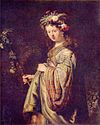
|
Saskia as Flora (1634) |
125 cm × 101 cm oil on canvas |
Hermitage in Saint Petersburg |

|
Belshazzar's Supper (1635/1639) |
209 cm × 167 cm oil on canvas |
National Gallery in London |

|
Entombment of Christ (1635) |
32 cm × 40.5 cm oil on wood |
Hunterian Museum and Art Gallery in Glasgow |
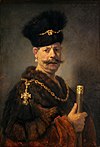
|
A Polish nobleman (1637) |
96.8 cm × 66 cm oil on wood |
National Gallery of Art in Washington, DC |

|
Dead peacocks (1639) |
145 cm × 135.5 cm oil on canvas |
Rijksmuseum in Amsterdam |

|
Portrait of Agatha Bas (1641) |
104 cm × 82 cm oil on canvas |
Buckingham Palace in London |
|
The scholar at the lectern
(1641) |
105.7 cm x 76.3 cm
oil on wood |
Warsaw Royal Castle
in Warsaw |
|
|
The girl in the hat
(1641) |
105.5 cm × 76 cm
oil on wood |
Warsaw Royal Castle
in Warsaw |
|

|
The Night Watch (1642) |
437 cm × 363 cm oil on canvas |
Rijksmuseum in Amsterdam |

|
Christ and the Adulteress (1644) |
83.8 cm × 65.4 cm oil on wood |
National Gallery in London |

|
Susanna and the two elders (1647) |
76.5 cm × 92.8 cm oil on wood |
Picture gallery in Berlin |

|
The Hundred Guilder Leaf (Christ to whom the Small Children are Brought) (1647–1649) |
27.8 cm × 38.8 cm drypoint etching |
Rijksmuseum in Amsterdam |

|
Christ at Emmaus (1648) |
68 cm × 65 cm oil on wood |
Louvre in Paris |

|
A Christ after Life (1648) |
25 cm × 21.5 cm oil on wood |
Picture gallery in Berlin |
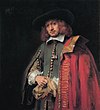
|
Portrait of Jan Six (1654) |
112 cm × 102 cm oil on canvas |
Collectie Six in Amsterdam |

|
Hendrickje bathing (1655) |
61.8 cm × 47 cm oil on wood |
National Gallery in London |

|
The Polish Horseman (1655) |
115 cm × 135 cm oil on canvas |
Frick Collection in New York City |

|
Jacob's Blessing (1656) |
211 cm × 178 cm oil on canvas |
Old Masters Picture Gallery in Kassel |

|
Anatomical lecture by Dr. Deyman (fragment) (1656) |
100 cm × 134 cm oil on canvas |
Amsterdam Museum in Amsterdam |

|
The Refusal of Saint Peter (1660) |
154 cm × 169 cm oil on canvas |
Rijksmuseum Amsterdam in Amsterdam |

|
Rembrandt's son Titus (1660) |
79.5 cm × 67.7 cm oil on canvas |
Rijksmuseum Amsterdam in Amsterdam |

|
Two young Africans (1661) |
78 cm × 64.5 cm oil on canvas |
Mauritshuis in The Hague |

|
The Conspiracy of Julius Civilis (fragment) (1661/1662) |
196 cm × 309 cm oil on canvas |
Swedish National Museum in Stockholm |

|
Portrait of the Head of the Cloth Makers' Guild (1662) |
191.5 cm × 279 cm oil on canvas |
Rijksmuseum in Amsterdam |

|
Self-Portrait as Zeuxis (1663) |
82.5 cm × 65 cm oil on canvas |
Wallraf-Richartz-Museum & Fondation Corboud in Cologne |

|
Self-Portrait (1665) |
114 cm × 94 cm oil on canvas |
Kenwood House in London |

|
The Jew's Bride (around 1666) |
121.5 cm × 166.5 cm oil on canvas |
Rijksmuseum in Amsterdam |
literature
sorted alphabetically by authors / editors
- Eckbert Albers: Moments of cognition and cognitive processes at Rembrandt. Georg Olms Verlag, Hildesheim 2008, ISBN 978-3-487-13831-2 .
- Svetlana Alpers: Rembrandt as an entrepreneur. His studio and the market. DuMont literature and art, Cologne 2003, ISBN 3-8321-7297-1 .
- Kristin Bahre et al. (Ed.): Rembrandt. Genius in search. DuMont literature and art, Cologne 2006, ISBN 3-8321-7694-2 .
- Renate Barth: Rembrandt. Etchings. Weimar Classics Foundation and Art Collections, Weimar 1981, ISBN 3-929323-03-6 .
- Holm Bevers: Rembrandt. The drawings in the Berlin Kupferstichkabinett. Critical catalog. Hatje Cantz, Ostfildern 2006, ISBN 3-7757-1817-6 .
- J. Bruyn, B. Haak et al .: A Corpus of Rembrandt Paintings :
- Volume 1: 1625-1631. Kluwer Academic Publishers, 1982, ISBN 90-247-2614-X
- Volume 2: 1631-1634. Volume 2, 1986, ISBN 90-247-3339-1
- Volume 3: 1635-1642. 1990, ISBN 90-247-3781-8
- Nils Büttner : Rembrandt: Light and Shadow. A biography. Reclam, Stuttgart 2014, ISBN 978-3-15-010965-6 .
- H. Perry Chapman: Rembrandt's self-portraits. University Press, Princeton NJ 1990, ISBN 0-691-04061-3 .
- Jean Genet : Rembrandt. A fragment. Merlin-Verlag, Gifkendorf 1996, ISBN 3-926112-61-1 .
- Amy Golahny: Rembrandt's Reading: The Artist's Bookshelf of Ancient Poetry and History , Amsterdam University Press, 2003.
- Michael Kitson: Rembrandt. Phaidon Press, New York City 2007, ISBN 978-0-7148-2743-8 .
- Maria Kreutzer: Rembrandt and the Bible - Etchings, Drawings, Commentaries. Reclam-Verlag, Stuttgart 2003, ISBN 3-15-010539-0 .
- Jürgen Müller: The Socratic artist. Studies on Rembrandt's Night Watch. Brill, Leiden 2015, ISBN 978-90-04-28525-5 .
- Otto Pächt : Rembrandt. Edited by Edwin Lachnit. Prestel, Munich 1991. (2nd edition. 2005)
- Simon Schama : Rembrandt's eyes. Siedler Verlag, Berlin 2000, ISBN 3-88680-702-9 .
- Gary Schwartz: The Rembrandt Book. The life and work of a genius. CH Beck Verlag, Munich 2006, ISBN 3-406-54369-3 .
- Anna Seghers : Jew and Judaism in Rembrandt's Work. Dissertation 1924. Philipp Reclam, Leipzig 1981, ISBN 3-379-00608-4 . (48 reproductions (b / w))
- Hans W. Singer , Jaro Springer (ed.): Rembrandts all etchings. Holbein, Munich undated [1914]. (312 reproductions)
- Christian Tümpel : Rembrandt. Myth and Method. Langewiesche, Königstein / T. 1986, ISBN 3-7845-9290-2 .
- Christian Tümpel: Rembrandt. Rowohlt Taschenbuch Verlag, Reinbek 2006, ISBN 3-499-50691-2 .
- Christian Tümpel: Rembrandt. Images and Metaphors. House Publishing, London 2006, ISBN 1-904950-92-2 .
- Anette Wauschkuhn: Georg Simmel's Rembrandt-Bild: A contribution to the philosophy of life to the reception of Rembrandt in the 20th century = manuscripts for art history in the Wernersche Verlagsgesellschaft 61. Wernersche Verlagsgesellschaft, Worms 2002, ISBN 978-3-88462-960-4 .
- Walter Weichhardt: Rembrandt. Etchings. German Book Community, Berlin 1939.
- Joseph Eduard Wessely : Rembrandt van Rijn . In: Allgemeine Deutsche Biographie (ADB). Volume 28, Duncker & Humblot, Leipzig 1889, pp. 193-197.
- Ernst van de Wetering, Karin Groen, among others: A Corpus of Rembrandt Paintings :
- Volume 4: Self-Portraits. Springer-Verlag, Dordrecht 2005, ISBN 1-4020-3280-3 .
- Volume 5: The Small-Scale History Paintings. Springer-Verlag, Dordrecht 2011, ISBN 978-1-4020-4607-0 .
- Volume 6: Rembrandt's Paintings Revisited - A Complete Survey. Springer-Verlag, Dordrecht 2015, ISBN 978-94-017-9173-1 .
- Christopher White: Rembrandt as an etcher. Yale University Press, New Haven, Conn. 1999, ISBN 0-300-07953-2 .
- Christopher White (Ed.): Rembrandt's Self-Portraits. Belser Verlag, Stuttgart 1999, ISBN 3-7630-2370-4 .
- Christopher Wright: Rembrandt. Self-portraits. Hirmer, Munich 2000, ISBN 3-7774-8580-2 .
- Wrong gold helmet. In: The time . No. 29/2006; Interview with the Rembrandt researcher Ernst van de Wetering
Web links
- The Rembrandt Database
- Literature by and about Rembrandt van Rijn in the catalog of the German National Library
- Works by and about Rembrandt van Rijn in the German Digital Library
- Rembrandt van Rijn in the catalog of the Cologne Art Library
- Works by Rembrandt van Rijn at Zeno.org
- Rembrandt van Rijn: Life and Art, archived on Archive.org ( Memento of April 13, 2007 in the Internet Archive )
- Rijn, Rembrandt Harmensz. van online database of the Gemäldegalerie Alte Meister Kassel
Individual evidence
- ^ A b Ernst van de Wetering: Rembrandt, a biography. In: Kristin Bahre et al. (Ed.): Rembrandt. Genius in search. DuMont Literature and Art, Cologne 2006, pp. 21–49, here: p. 24.
- ↑ Michael Kitson: Rembrandt. Phaidon Press, New York 2007, p. 25.
- ↑ Ernst van de Wetering: Rembrandt, a biography. In: Kristin Bahre et al. (Ed.): Rembrandt. Genius in search. DuMont Literature and Art, Cologne 2006, pp. 21–49, here: p. 25.
- ↑ a b c Michael Bockemühl: Rembrandt. Taschen, Cologne 2001, p. 94.
- ^ Christian Tümpel: Rembrandt in self-testimonies and picture documents. Reinbek 1977, p. 19.
- ^ A b Ernst van de Wetering: Rembrandt, a biography. In: Kristin Bahre et al. (Ed.): Rembrandt. Genius in search . DuMont Literature and Art, Cologne 2006, pp. 21–49, here: p. 27.
- ↑ a b c David Bomford, Jo Kirby, Ashok Roy, Axel Rüger, Raymond White: Art in the Making: Rembrandt . National Gallery Company, London 2006, p. 17.
- ↑ a b c Ernst van de Wetering: Rembrandt, a biography. In: Kristin Bahre et al. (Ed.): Rembrandt. Genius in search. DuMont Literature and Art, Cologne 2006, pp. 21–49, here: p. 30.
- ↑ a b Christian Tümpel: Rembrandt in personal testimonies and picture documents. Rowohlt, Reinbek 1977, p. 63.
- ^ Christian Tümpel: Rembrandt in self-testimonies and picture documents. Rowohlt, Reinbek 1977, p. 90.
- ↑ Michael Bockemühl: Rembrandt. Taschen, Cologne 2001, p. 95.
- ^ Christian Tümpel: Rembrandt in self-testimonies and picture documents. Rowohlt, Reinbek 1977, p. 92.
- ^ Christian Tümpel: Rembrandt in self-testimonies and picture documents. Rowohlt, Reinbek 1977, p. 97.
- ↑ Ernst van de Wetering: Rembrandt, a biography. In: Kristin Bahre et al. (Ed.): Rembrandt. Genius in search. DuMont Literature and Art, Cologne 2006, pp. 21–49, here: p. 45.
- ↑ Christoph Driessen: Rembrandt and the women. Pustet, Regensburg 2011, p. 132.
- ↑ Christoph Driessen: Rembrandt and the women. Regensburg 2011, pp. 133-142.
- ↑ Among other things by the German art historian Wilhelm Reinhold Valentiner (1880-1958) in: Rembrandt. Recovered paintings. 1910-1920. See also: Anna Brzyski: Partisan Canons. Duke University Press, 2007, ISBN 978-0-8223-4106-2 , pp. 225ff.
- ↑ Niklas Maak: Rembrandt - In the shadow of golden time blossoms. faz.net; Retrieved October 18, 2008.
- ^ Christian Tümpel: Rembrandt in self-testimonies and picture documents. Rowohlt, Reinbek 1977, pp. 21, 22.
- ^ Christian Tümpel: Rembrandt in self-testimonies and picture documents. Rowohlt, Reinbek 1977, p. 65.
- ↑ Kristin Bahre et al. (Ed.): Rembrandt - Genius in Search. DuMont Literature and Art, Cologne 2006, p. 282.
- ^ Christian Tümpel: Rembrandt in self-testimonies and picture documents. Rowohlt, Reinbek 1977, p. 59.
- ^ Christian Tümpel: Rembrandt in self-testimonies and picture documents. Rowohlt, Reinbek 1977, p. 60.
- ^ Eva Mongi-Vollmer: Masterpieces in the Städel Museum. Städel Museum, Frankfurt am Main 2007, p. 128.
- ↑ Michael Bockemühl: Rembrandt. Taschen, Cologne 2001, p. 20.
- ↑ a b Michael Bockemühl: Rembrandt. Taschen, Cologne 2001, pp. 18-20.
- ↑ a b Christian Tümpel: Rembrandt in personal testimonies and picture documents. Rowohlt, Reinbek 1977, p. 117.
- ^ Christian Tümpel: Rembrandt in self-testimonies and picture documents. Rowohlt, Reinbek 1977, p. 121.
- ^ A b Ernst van de Wetering: Rembrandt, a biography. In: Kristin Bahre et al. (Ed.): Rembrandt. Genius in search . DuMont Literature and Art, Cologne 2006, pp. 21–49, here: p. 31.
- ↑ a b Christian Tümpel: Rembrandt in personal testimonies and picture documents. Rowohlt, Reinbek 1977, p. 56.
- ↑ Michael Bockemühl: Rembrandt . Taschen, Cologne 2001, p. 40.
- ↑ Michael Bockemühl: Rembrandt . Taschen, Cologne 2001, p. 41.
- ↑ Michael Bockemühl: Rembrandt . Taschen, Cologne 2001, p. 49.
- ↑ Michael Bockemühl: Rembrandt . Taschen, Cologne 2001, p. 52.
- ^ Christian Tümpel: Rembrandt in self-testimonies and picture documents. Rowohlt, Reinbek 1977, pp. 84 and 85.
- ↑ a b Christian Tümpel: Rembrandt in personal testimonies and picture documents. Rowohlt, Reinbek 1977, p. 80.
- ↑ Michael Kitson: Rembrandt. Phaidon Press. New York 2007, p. 122.
- ^ Svetlana Alpers : Rembrandt as an entrepreneur. His studio and the market . DuMont, Cologne 1989, p. 263.
- ↑ a b Michael Bockemühl: Rembrandt. Taschen, Cologne 2001, p. 7.
- ^ Christian Tümpel: Rembrandt in self-testimonies and picture documents. Rowohlt, Reinbek 1977, p. 125.
- ^ Christian Tümpel: Rembrandt in self-testimonies and picture documents. Rowohlt, Reinbek 1977, p. 126.
- ↑ Samuel Herzog: Groundless or Wise? - 'Rembrandt Rembrandt' in the Frankfurt Städel. In: Feuilleton of the NZZ. February 10, 2003, accessed October 6, 2008
- ↑ Christiaan Vogelaar, Rembrandt Harmenszoon van Rijn, Gregor JM Weber, Boudewijn Bakker, Lynne Richards, Jaco Rutgers, Ruth Koenig: Rembrandt's Landscapes. Wanderers; Stedelijk Museum De Lakenhal, 2006, ISBN 90-400-8234-0 .
- ↑ a b c Michael Kitson: Rembrandt. Phaidon Press. New York 2007, p. 68.
- ↑ a b Michael Kitson: Rembrandt. Phaidon Press. New York 2007, p. 24.
- ↑ a b Michael Kitson: Rembrandt. Phaidon Press. New York 2007, p. 78.
- ^ Christian Tümpel: Rembrandt in self-testimonies and picture documents. Rowohlt, Reinbek 1977, p. 112.
- ↑ Ernst van de Wetering: Rembrandt, a biography. In: Kristin Bahre et al. (Ed.): Rembrandt. Genius in search . DuMont Literature and Art, Cologne 2006, pp. 21–49, here: p. 38.
- ↑ Michael Bockemühl: Rembrandt. Taschen, Cologne 2001, p. 67.
- ↑ Michael Bockemühl: Rembrandt. Taschen, Cologne 2001, pp. 67 and 68.
- ↑ Werner Busch : Chapter 6: Rembrandt's late drawings with the reed pen. In: The unclassical picture. From Titian to Constable and Turner. CH Beck, Munich 2009, p. 131f.
- ^ Christian Tümpel: Rembrandt in self-testimonies and picture documents . Rowohlt, Reinbek 1977, p. 93.
- ^ Christian Tümpel: Rembrandt in self-testimonies and picture documents . Rowohlt, Reinbek 1977, p. 101.
- ↑ Matthew 27, verse 54 on bibleserver.com; Retrieved October 4, 2008
- ↑ a b Christian Tümpel: Rembrandt in personal testimonies and picture documents . Rowohlt, Reinbek 1977, p. 103.
- ^ A b Ernst van de Wetering: Rembrandt, a biography. In: Kristin Bahre et al. (Ed.): Rembrandt. Genius in search . DuMont Literature and Art, Cologne 2006, pp. 21–49, here: p. 46.
- ^ Christian Tümpel: Rembrandt in self-testimonies and picture documents. Rowohlt, Reinbek 1977, p. 111 and 112.
- ↑ Ernst van de Wetering: Rembrandt, a biography. In: Kristin Bahre et al. (Ed.): Rembrandt. Genius in search . DuMont Literature and Art, Cologne 2006, pp. 21–49, here: p. 28.
- ^ Christian Tümpel: Rembrandt in self-testimonies and picture documents. Rowohlt, Reinbek 1977, p. 110.
- ^ A b Ernst van de Wetering: Rembrandt, a biography. In: Kristin Bahre et al. (Ed.): Rembrandt. Genius in search . DuMont Literature and Art, Cologne 2006, pp. 21–49, here: p. 29.
- ↑ Ernst van de Wetering: Rembrandt, a biography. In: Kristin Bahre et al. (Ed.): Rembrandt. Genius in search. DuMont Literature and Art, Cologne 2006, pp. 21–49, here: p. 37. Original: “… there having bin in this Country Many excellent Men in thatt Faculty, some att Presentt, as Rimbrandtt, etts,…” in: Ernst van de Wetering: Rembrandt, a biography. In: Kristin Bahre et al. (Ed.): Rembrandt. Genius in search. DuMont Literature and Art, Cologne 2006, pp. 21–49, here: p. 49.
- ↑ Original: "dat hy got is, een vandele tegenwoordighe vermaertse Schilders van onse eeuwe". In: Ernst van de Wetering: Rembrandt, a biography. In: Kristin Bahre et al. (Ed.): Rembrandt. Genius in search . DuMont Literature and Art, Cologne 2006, pp. 21–49, here: p. 49.
- ↑ a b Christian Tümpel: Rembrandt in personal testimonies and picture documents. Rowohlt, Reinbek 1977, p. 130.
- ^ Christian Tümpel: Rembrandt in self-testimonies and picture documents. Rowohlt, Reinbek 1977, p. 128.
- ↑ Jan Kelch : Rembrandt then and now. Art criticism and connoisseurship. In: Kristin Bahre et al. (Ed.): Rembrandt. Genius in search. DuMont Literature and Art, Cologne 2006, pp. 203–223, here: pp. 216 and 217.
- ↑ Jan Kelch: Rembrandt then and now. Art criticism and connoisseurship. In: Kristin Bahre et al. (Ed.): Rembrandt. Genius in search. DuMont Literature and Art, Cologne 2006, pp. 203–223, here: p. 216.
- ^ John Smith: A catalog raisonné of the works of the most eminent Dutch, Flemish, and French painters . Volume 7. London 1836 ( digitized ).
- ↑ a b Christian Tümpel: Rembrandt in personal testimonies and picture documents. Rowohlt, Reinbek 1977, p. 131.
- ↑ Jan Kelch: Rembrandt then and now. Art criticism and connoisseurship. In: Kristin Bahre et al. (Ed.): Rembrandt. Genius in search. DuMont Literature and Art, Cologne 2006, pp. 203–223, here: pp. 220 and 221.
- ↑ a b Jan Kelch: Rembrandt then and now. Art criticism and connoisseurship. In: Kristin Bahre et al. (Ed.): Rembrandt. Genius in search. DuMont Literature and Art, Cologne 2006, pp. 203–223, here: p. 221.
- ↑ world art. 01/2010, p. 92.
- ↑ Jan Kelch: Rembrandt then and now. Art criticism and connoisseurship. In: Kristin Bahre et al. (Ed.): Rembrandt. Genius in search. DuMont Literature and Art, Cologne 2006, pp. 203–223, here: p. 208.
- ↑ a b Kristin Bahre et al. (Ed.): Rembrandt. Genius in search. DuMont Literature and Art, Cologne 2006, p. 209.
- ↑ a b Kristin Bahre et al. (Ed.): Rembrandt. Genius in search. DuMont Literature and Art, Cologne 2006, p. 258.
- ↑ Jan Kelch: Rembrandt then and now. Art criticism and connoisseurship. In: Kristin Bahre et al. (Ed.): Rembrandt. Genius in search. DuMont Literature and Art, Cologne 2006, pp. 203–223, here: p. 210.
- ↑ Kristin Bahre et al. (Ed.): Rembrandt. Genius in search. DuMont literature and art, Cologne 2006, p. 312.
- ↑ Rembrandt as an influential role model. on: kunstmarkt.com ; Retrieved January 20, 2009.
- ^ Katrin Boskamp: Studies on the early work of Max Liebermann: With a catalog of paintings and oil studies from 1866–1889 . Hildesheim 1994, p. 108.
- ↑ Description of the exhibition. ( Memento from January 23, 2008 in the Internet Archive ) hamburger-kunsthalle.de; Retrieved January 20, 2008
- ↑ Helmut Börsch-Supan , Hans Dickel, Christoph Martin Vogtherr : Preussen, the art and the individual. Berlin 2003, p. 84.
- ^ Image: Joseph Beuys (after Rembrandt) by Glenn Brown ( Memento from May 10, 2009 in the Internet Archive ) on frankfurtlounge.de; Retrieved May 15, 2009
- ↑ Image: After Rembrandt by Devorah Sperber on devorahsperber.com; Retrieved January 18, 2009
- ↑ Christiane Kruse: From the origin of pictures from the fear of death and oblivion. In: Torsten Hoffmann, Gabriele Rippl (Ed.): Images: A (new) leading medium? Göttingen 2006. pp. 15–42, here: p. 34.
- ↑ Self-Portrait 1659 ( Memento from November 27, 2016 in the Internet Archive ), accessed on November 26, 2016.
- ↑ Review of “The Painter's Assistant: A Rembrandt Novel” on literaturommunikel.eu, accessed on October 10, 2008. ( Memento from February 13, 2013 in the web archive archive.today )
- ↑ Rembrandt thriller! - Does art history have to be rewritten? ( Memento from October 25, 2008 in the Internet Archive )
| personal data | |
|---|---|
| SURNAME | Rembrandt van Rijn |
| ALTERNATIVE NAMES | Rembrandt Harmensz van Rijn; Rembrandt (shortened) |
| BRIEF DESCRIPTION | Dutch painter |
| DATE OF BIRTH | July 15, 1606 |
| PLACE OF BIRTH | Suffer |
| DATE OF DEATH | October 4, 1669 |
| PLACE OF DEATH | Amsterdam |
